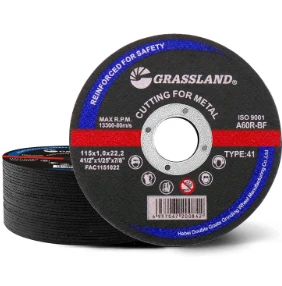Understanding the Types of Cutting Discs A Comprehensive Guide
Cutting discs are essential tools in various industries, including metalworking, woodworking, and construction. They are designed to slice through different materials with precision and ease. Understanding the types of cutting discs available in the market can help professionals and DIY enthusiasts choose the right disc for their specific needs, ensuring safety and efficiency in their projects.
Types of Cutting Discs
1. Metal Cutting Discs Metal cutting discs are specifically designed for cutting through ferrous and non-ferrous metals. These discs are made from high-quality materials, often featuring a blend of abrasive composites. They typically have a thickness ranging from 1 to 3 mm. The thinner discs are ideal for precise cuts and quicker workflows, while thicker discs offer durability and are better suited for heavy-duty applications. Common sizes include 4.5-inch, 7-inch, and 14-inch, making them versatile in various settings like workshops and construction sites.
2. Stone Cutting Discs Stone cutting discs, as the name suggests, are used for cutting stone, concrete, and masonry materials. These discs are often diamond-tipped, providing an extended lifespan and the ability to slice through hard materials with minimal effort. They come in various shapes, including turbo, segmented, and continuous rim designs, each catering to specific cutting needs. Turbo discs are great for fast cutting, segmented discs excel at cooling and preventing overheating, while continuous rim discs deliver smooth, fine cuts.
3. Wood Cutting Discs Designed primarily for woodworking, wood cutting discs vary significantly in design to achieve different finishes. Circular saw blades are a common form, with teeth and spacing tailored for specific wood types. These discs can feature carbide tips for enhanced durability and a cleaner cut. For various applications, wood cutting discs are available in diameter sizes from 4 to 12 inches, suitable for hand saws, table saws, and other woodworking machinery.
4. Multi-Material Cutting Discs Multi-material cutting discs are versatile tools designed to handle various materials, including metal, plastic, and wood. These discs often incorporate a blend of materials, making them suitable for projects that involve cutting multiple surfaces. They provide a practical solution for those who want to avoid changing discs frequently while working on diverse materials. However, they may not be as efficient or long-lasting as specialized discs for specific materials.
types of cutting discs

5. Ceramic Cutting Discs Ceramic cutting discs are specifically engineered to cut through ceramics and porcelain. Their design typically incorporates a diamond coating to provide precision and durability. These discs are optimal for tile cutting, allowing for clean edges that minimize the chances of breakage during installation. The right choice of ceramic disc can significantly enhance the quality of tile-setting projects, making the cutting process simpler and more efficient.
6. Angle Grinder Discs Often used in conjunction with angle grinders, these discs come in a range of styles, including grinding, polishing, and flap discs. While primarily used for grinding and finishing surfaces, certain configurations can also function effectively to cut through materials. Flap discs, in particular, are popular for achieving a smooth finish and are especially useful in metalworking applications.
Choosing the Right Cutting Disc
When selecting a cutting disc, several factors should be considered
- Material Compatibility Always choose a disc that matches the material being cut. Using the wrong disc can lead to damage or accidents. - Thickness of the Disc Thinner discs allow for quicker cuts but may wear out faster, while thicker discs provide durability at the cost of cutting speed. - Disc Size The size of the cutting disc should correspond to the machinery being used. Ensuring compatibility is vital for safety and operational efficiency. - Desired Finish If a smooth finish is essential, consider the design and type of disc, as some are tailored for finer cuts than others.
Conclusion
Understanding the different types of cutting discs and their applications is crucial for achieving optimal results in various cutting tasks. By selecting the correct disc for your material and project requirements, you can enhance efficiency, improve safety, and obtain quality finishes in your work. Whether you are a professional tradesperson or a DIY enthusiast, investing time into learning about cutting discs will pay off in the long run, leading to more successful and enjoyable projects.
Post time:Dec - 06 - 2024

















